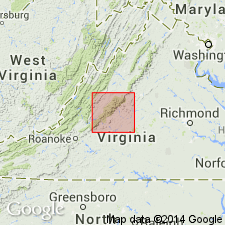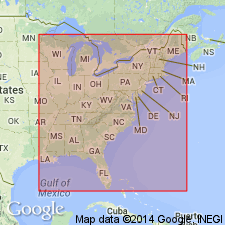
- Usage in publication:
-
- Pedlar formation
- Modifications:
-
- Named
- Dominant lithology:
-
- Granite
- Granodiorite
- Syenite
- AAPG geologic province:
-
- Piedmont-Blue Ridge province
Summary:
The name Pedlar formation is here proposed for the unit which forms most of the basement complex of the Blue Ridge northeast of Roanoke, VA, and many masses surrounded by the Marshall and Lovingston formations in the Piedmont. Previously defined and mapped as hypersthene granodiorite, it consists of an assemblage of granitic, granodioritic, syenitic, quartz dioritic, anorthositic, and unakitic rocks undifferentiable in the field. Described as green, white, or red, coarse-grained, granulose rock with a palimpsest foliation in vague traces and porphyroblasts up to 4 in. in diameter. Mineral assemblage includes potash feldspar, oligoclase-andesine, oligoclase, and quartz in variable proportions with some hypersthene and diopside as accessories. In the Piedmont and along the southeastern foot of the Blue Ridge, this formation grades into the Marshall and Lovingston formations, but within the Blue Ridge it is unconformably overlapped by a sequence of late Precambrian and Early Cambrian formations.
Source: GNU records (USGS DDS-6; Reston GNULEX).

- Usage in publication:
-
- Pedlar Formation*
- Modifications:
-
- Geochronologic dating
- AAPG geologic province:
-
- Piedmont-Blue Ridge province
Summary:
Used in tables 5 and 6 as Pedlar Formation. Isotopic dating yielded Rb-Sr whole rock isochron ages of 1021 +/-36 Ma (Pettingill and others, 1984) and 1042 +/-59 Ma (Herz and others, 1981); 207Pb/206Pb ages of 1130 Ma (Tilton and others, 1960), 1031 and 1027 Ma (Sinha and Bartholomew, 1984), and 1040 Ma, interpreted to be age of source or result of mixing (Herz and Force, 1987); and U-Pb zircon upper intercept ages of 1138 and 1041 Ma (calculated by T.W. Stern from existing data) and 1075 Ma (Tilton and others, 1960).
Source: GNU records (USGS DDS-6; Reston GNULEX).
For more information, please contact Nancy Stamm, Geologic Names Committee Secretary.
Asterisk (*) indicates published by U.S. Geological Survey authors.
"No current usage" (†) implies that a name has been abandoned or has fallen into disuse. Former usage and, if known, replacement name given in parentheses ( ).
Slash (/) indicates name conflicts with nomenclatural guidelines (CSN, 1933; ACSN, 1961, 1970; NACSN, 1983, 2005, 2021). May be explained within brackets ([ ]).

